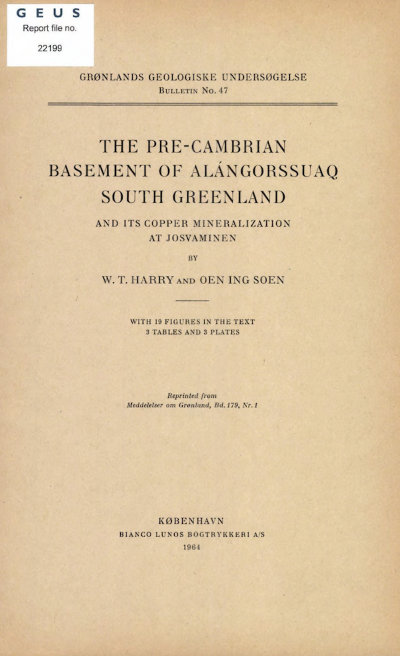The pre-Cambrian basement of Alángorssuaq South Greenland and its copper mineralization at Josvaminen
DOI:
https://doi.org/10.34194/bullggu.v47.6581Abstract
The pre-Cambrian basement of Alângorssuaq, S. Greenland, comprises two main units, the Green Schists and Julianehåb Granite. The first unit, a series of sediments and basic lavas, including pillow lavas, folded and regionally metamorphosed during the Ketilidian orogeny, has been invaded and locally migmatized by the Julianehåb Granite. The last is chiefly a pink even-grained quartz – microcline oligoclase – biotite – hornblende – rock passing into a darker less quartzose basified phase containing prominent felspars. A later medium-grained leucocratic variety also occurs. Numerous thin dykes intruding the normal and the basified granite were recrystallized together with their country rocks during moderate regional metamorphism and some have been attacked by remobilized granite. Many chiefly basic dykes of later (Gardar) age cut the basement. Metasomatism occurs at various places throughout the area, its most striking effects in granite being desilication and formation of albite, often with chessboard structure due to replacement of microcline during deformation. Other products include garnet (apparently rich in grossularite) diopside and haematite. Pneumatolytic-hydrothermal topomineralic reaction deposits in Green Schists at Josvaminen formed at an estimated depth of 1-3 km over temperatures between 6000 and less than 1000 C. Mineralization commenced with felspathization of Ketilidian granitic rocks. To this phase some, if not all, of the syenitization of Julianehåb Granite elsewhere in Alângorssuaq may be assigned. After an interval of time, which might have been considerable, fracturing ensued. In the schists the resultant fissures became filled by fluids from which garnet, scapolite, prehnite, diopside, actinolite and calcite were precipitated under high fluid pressures and osmotic conditions. Temperature and pressure gradients falling outwards from the voids controlled a fissure-metasomatism involving migration of lime towards the voids around which pronounced epidotization resulted. These reactions ceased and felspathization resumed locally when fluid pressures or partial water vapour pressure became unfavourable for epidotization, or lime was exhausted in the fluids. Abstraction of other elements by silicates during felspathization and epidotization concentrated Cu and other metals in the later stage fluids, and copper ores were deposited along faults under rapidly falling temperatures and pressures, the paragenetic sequence epidote-haematite-bornite-chalcocite being explained by the topomineralic effects of the wall-rocks. Epidotization of chlorite-schists consumed much of the iron and, perhaps, by liberation of hydroxyl groups increased oxygen partial pressures with resultant crystallization of haematite and further consumption of iron; so only relatively iron-poor bornite and chalcocite could form subsequently. Supergene enrichment is insignificant. The mineralizing fluids were characterized by a high alkali and volatile content, low silica, Ca, Mg, Fe, AI content and a high ratio Fe/Ca. They may be connected with alkaline Gardar igneous intrusions, in particular the Nunarssuit complex which lies close at hand. However, most of the Ca, Mg, Fe, Si, Al and Cu in the minerals they produced was derived from the country rocks, and earlier phases of copper concentration may have taken place.
Downloads
Published
Issue
Section
License
This article is distributed under a CC-BY 4.0 licence, permitting free redistribution and reproduction for any purpose, even commercial, provided proper citation of the original work. Author(s) retain copyright over the article contents.


